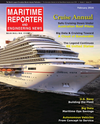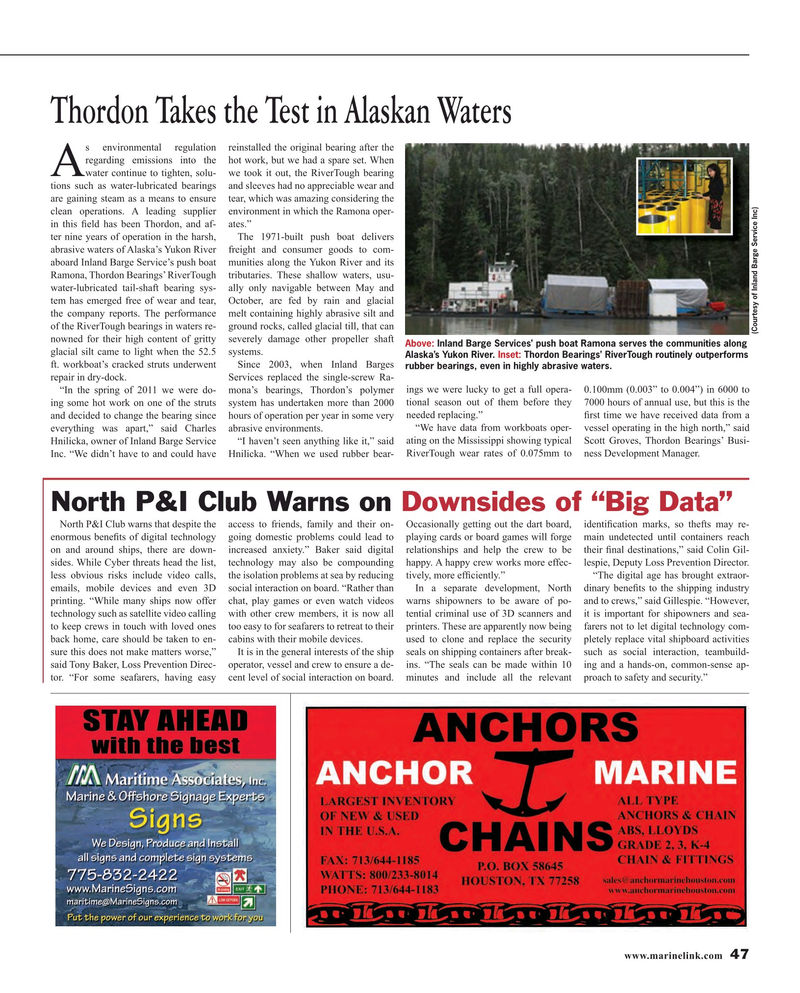
Page 47: of Maritime Reporter Magazine (February 2016)
Cruise Ship Technology Edition
Read this page in Pdf, Flash or Html5 edition of February 2016 Maritime Reporter Magazine
Thordon Takes the Test in Alaskan Waters s environmental regulation reinstalled the original bearing after the regarding emissions into the hot work, but we had a spare set. When
Awater continue to tighten, solu- we took it out, the RiverTough bearing tions such as water-lubricated bearings and sleeves had no appreciable wear and are gaining steam as a means to ensure tear, which was amazing considering the clean operations. A leading supplier environment in which the Ramona oper- in this ? eld has been Thordon, and af- ates.” ter nine years of operation in the harsh, The 1971-built push boat delivers abrasive waters of Alaska’s Yukon River freight and consumer goods to com- aboard Inland Barge Service’s push boat munities along the Yukon River and its
Ramona, Thordon Bearings’ RiverTough tributaries. These shallow waters, usu- water-lubricated tail-shaft bearing sys- ally only navigable between May and tem has emerged free of wear and tear, October, are fed by rain and glacial the company reports. The performance melt containing highly abrasive silt and of the RiverTough bearings in waters re- ground rocks, called glacial till, that can (Courtesy of Inland Barge Service Inc) nowned for their high content of gritty severely damage other propeller shaft
Above: Inland Barge Services’ push boat Ramona serves the communities along glacial silt came to light when the 52.5 systems.
Alaska’s Yukon River. Inset: Thordon Bearings’ RiverTough routinely outperforms ft. workboat’s cracked struts underwent Since 2003, when Inland Barges rubber bearings, even in highly abrasive waters.
repair in dry-dock. Services replaced the single-screw Ra- “In the spring of 2011 we were do- mona’s bearings, Thordon’s polymer ings we were lucky to get a full opera- 0.100mm (0.003” to 0.004”) in 6000 to ing some hot work on one of the struts system has undertaken more than 2000 tional season out of them before they 7000 hours of annual use, but this is the and decided to change the bearing since hours of operation per year in some very needed replacing.” ? rst time we have received data from a everything was apart,” said Charles abrasive environments. “We have data from workboats oper- vessel operating in the high north,” said
Hnilicka, owner of Inland Barge Service “I haven’t seen anything like it,” said ating on the Mississippi showing typical Scott Groves, Thordon Bearings’ Busi-
Inc. “We didn’t have to and could have Hnilicka. “When we used rubber bear- RiverTough wear rates of 0.075mm to ness Development Manager.
North P&I Club Warns on Downsides of “Big Data”
North P&I Club warns that despite the access to friends, family and their on- Occasionally getting out the dart board, identi? cation marks, so thefts may re- enormous bene? ts of digital technology going domestic problems could lead to playing cards or board games will forge main undetected until containers reach on and around ships, there are down- increased anxiety.” Baker said digital relationships and help the crew to be their ? nal destinations,” said Colin Gil- sides. While Cyber threats head the list, technology may also be compounding happy. A happy crew works more effec- lespie, Deputy Loss Prevention Director.
less obvious risks include video calls, the isolation problems at sea by reducing tively, more ef? ciently.” “The digital age has brought extraor- emails, mobile devices and even 3D social interaction on board. “Rather than In a separate development, North dinary bene? ts to the shipping industry printing. “While many ships now offer chat, play games or even watch videos warns shipowners to be aware of po- and to crews,” said Gillespie. “However, technology such as satellite video calling with other crew members, it is now all tential criminal use of 3D scanners and it is important for shipowners and sea- to keep crews in touch with loved ones too easy to for seafarers to retreat to their printers. These are apparently now being farers not to let digital technology com- back home, care should be taken to en- cabins with their mobile devices. used to clone and replace the security pletely replace vital shipboard activities sure this does not make matters worse,” It is in the general interests of the ship seals on shipping containers after break- such as social interaction, teambuild- said Tony Baker, Loss Prevention Direc- operator, vessel and crew to ensure a de- ins. “The seals can be made within 10 ing and a hands-on, common-sense ap- tor. “For some seafarers, having easy cent level of social interaction on board. minutes and include all the relevant proach to safety and security.” www.marinelink.com 47
MR #2 (42-49).indd 47 2/5/2016 3:58:57 PM

 46
46

 48
48
